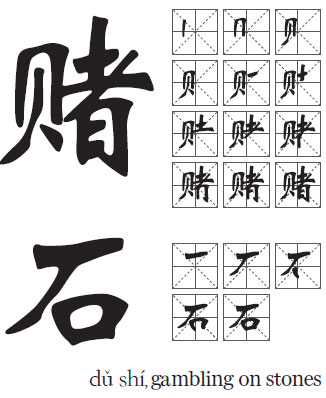Gambling on rocks

The curious practice of staking your savings on getting jade from a stone
Some people get rich quick by winning the lottery, and some get a lucky streak at a casino. But some instant millionaires have their success etched in stone.
Ruili is a small city near the border of Myanmar, which is China's biggest source of jade imports. This proximity to Myanmar's jade mines has meant the city of around 200,000 has become China's largest jade distribution center.


There, people hold flashlights up to every stone in the market, hoping to find a rock with precious jade inside.
Most, however, have a better chance of going broke after betting all their savings on a seemingly priceless rock that contains nothing of value.
The prices of irregular-shaped raw stones at jewel stores and on vendors' carts range from several hundred to millions of yuan, but their real value can only be found after they are bought and cut open - a sort of Schrodinger's stone, if you will.
Welcome to one of China's oldest forms of gambling.
Raw jade is almost always covered by base material and looks no different from any normal rock, yet people often fantasize about the glittering treasures hidden within. This fantasy forms the basis of the traditional business of dushi (赌石), gambling on stones.
It's a risky business. Neither the buyer nor the seller knows the quality of the stone. Even the most experienced connoisseur will know the old saying, "Even an fairy can't judge an inch of jade." (shén xiān nán duàn cùn yù, 神仙难断寸玉)
After buying a stone, the buyer will have to consider whether to cut it or not - and once open, it is either priceless or worthless.
If it's not opened, the mystery remains, and it can still be sold to another buyer, perhaps at an even higher price. A common trick is to make a small cut or scrape a bit off the surface. Assisted by a flashlight, buyers can check its color and transparency (important features for nice jade), and thus provide a "window" into the quality of the stone.
If that window is transparent enough and has a vivid color, buyers tend to believe there is quality jade inside, and the price of this rock will at least double - even though the bare areas may reveal nothing at all about the stone's content. Very often, experienced traders, uncertain of the quality, will sell the partly scraped stone to another buyer to transfer the risk.
For jade mine owners, selling the uncut stones to wholesalers is often the best way to make money.
Hundreds and thousands of metric tons of raw jade are mined every year, but only a small amount is valuable.
"If I cut and scrape all my stones before selling them, most of them will be sold cheaply and my business will suffer. The cost is too high," says the Chinese owner of a jade mine in Hpakant, Myanmar's Kachin State. "I just sell them all to wholesalers and some professional buyers."
It has been common practice to trade raw jade stones for many years, but today more amateurs, lured by potential fortunes, have flocked into the market to try their luck. Once they start on the road to this adventure, it's hard to stop, especially with occasional stories of someone finding a priceless stone among the slurry.
Tan Zhongxing, a jade trader in Chengdu, capital of Sichuan province, became famous after he bought a raw stone for 60,000 yuan ($9,270; 8,220 euros) from Myanmar in 2013 and found jadeite inside with seven different colors. "Eventually, a jade bracelet was carved out of it, and the estimated price went up to 400 million yuan," he says.
Many people came to Tan to buy the bracelet, but he refused them all. Instead, he stored it in a safe and it is now jointly owned by the National Museum.
"I don't want to put a price tag on it. A treasure should be appreciated from both an artistic and cultural perspective," he says.
Tan was a book publisher for decades and has only been in the jade business for five years, but thanks to the seven-colored bracelet he is now famous among jade traders.
Chinese people have always put a premium on jade, an obsession that dates back to the Spring and Autumn Period (770-476 BC). Confucius once said jade has the virtues a gentleman should have: its gloss, fine texture, purity and rigidity signify benevolence, knowledge, righteousness, and loyalty.
The first master of stone gambling was Bian He (卞和), a man said to have lived in Chu, an eastern state at the time.
Bian found a jade stone, recognized the value inside, and offered it to his king. However, the royal jeweler examined it and concluded it was just a stone, so the king branded Bian a liar and cut off his left foot.
Later, the king's son ascended the throne and Bian tried his luck again. The new king cut off his right foot. The third king, who saw the man crying for days and nights in front of the stone, finally had his jeweler cut it open and found a large, pure streak of jade, proving Bian a righteous and honest man (with no feet).
Jade experts today still admire Bian's certainty. To become a true expert, one must study - sometimes with a teacher, but mostly through trial and error.
Huang Hengzhong, 22, another jade dealer, has been learning how to distinguish precious jade from cheap stones since he was 17. After graduating from high school, instead of going to college, he moved to Ruili with his elder brother and mentor.
Huang learned that type, color and transparency are the three main features in evaluating jade: "You should check the transparency of the jade and texture inside it - the more transparent, the better. Be careful, or you may get fake jade made of glass or crystal. Then, you look at the color. Low-quality jade is colorless and full of irregular textures."
He also learned from more experienced dealers about the characteristics of different jade mines, and can now make a general judgment on where a piece of raw stone has come from.
"Some sites, especially the older ones, are known to have better jade with compact texture," he explains. "I also read geographical and chemical books on how jadeite was formed."
To gain hands-on experience, he even went to Myanmar, where 90 percent of the raw jade traded in China comes from. Most of the mines are in Hpakant.
Yet all this knowledge has not made him a gambler - and he has never actually cut a stone himself.
"I just sell raw stones imported from Myanmar," he adds. "Cutting is gambling. I don't gamble."
Courtesy of The World of Chinese, www.theworldofchinese.com
The World of Chinese
(China Daily European Weekly 03/25/2016 page23)
Today's Top News
- Takaichi must stop rubbing salt in wounds, retract Taiwan remarks
- Millions vie for civil service jobs
- Chinese landmark trade corridor handles over 5m TEUs
- China holds first national civil service exam since raising eligibility age cap
- Xi's article on CPC self-reform to be published
- Xi stresses improving long-term mechanisms for cyberspace governance






























